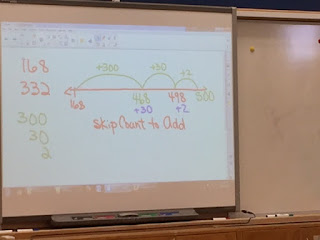In class this week we also looked at algorithms for adding and subtracting whole numbers. I was amazed to learn that there were actually additional methods of adding and subtracting numbers. Its funny because I was completely oblivious to the fact that basic math such as addition and subtraction could be taught in more ways than one and this is mostly due to the fact that growing up, I was only taught one way to formulate equations in school. In our class, we learned how to add and subtract using skip counting. I think that this alternative method of adding and subtracting is great because it not only gives students a different way to learn and understand the concepts of these processes but it also potentially provides students with a simpler way to calculate equations. For example, traditionally when subtracting whole numbers, we were taught to use borrowing. Many students have difficulty with the concept of borrowing and in my opinion it is not the best way of teaching subtraction and it is just one example of a method of teaching that has worked for some but will not work for everyone. The Image below displays an example of using skip counting to add: If a student has to add 168 to 332 they can place 168 on a line and turn 332 into 300 +30+2 when adding it to 168. Such as 168+300 =468 +30=498+2=500. See image below:

As educators we should be committed to providing our students with alternative algorithms so that they don’t have a false belief that there is “ only one way” to Add, subtract, multiply, and divide. With math scores and proficiency plummeting across the country there is a need for educators to provide students with the proper tools for success so that they can flourish in the future. Here is an interesting alternative algorithm video :)

